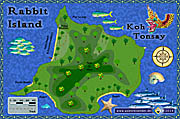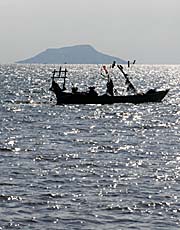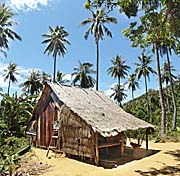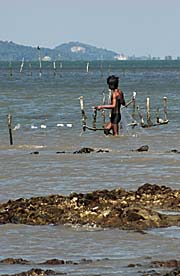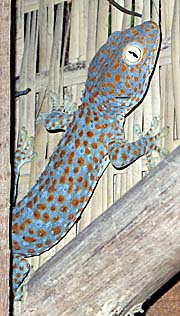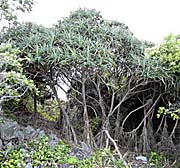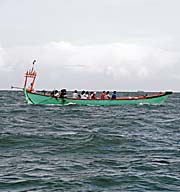Rabbit Island,
Koh Tonsay, Koh Thonsay
This very little tropical island is one of a number of islands situated in the Gulf of Thailand, close to Kep in Cambodia. A handful of (seven?) families live nowadays here. Their traditional occupation is fishing, but some do meanwhile business in tourism. Rabbit Island / Koh Tonsay is famous for Cambodian tourists from Phnom Penh who like to spend holidays and weekends in Kep and come over to here. A growing number of western tourists spend a day or more here as well.
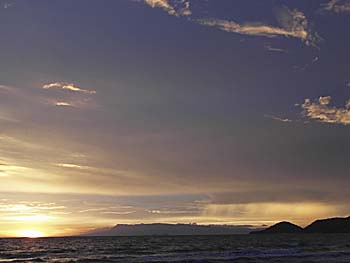
The sunset on Rabbit Island / Koh Tonsay are spectacular. Right hand is Kep, behind Bokor Mountain. In the background a rain front. In end May the southwest monsoon drives in. Image by Asienreisender, 5/2014
Access to Rabbit Island is possible by a boat from Kep pier for 8/10 US$ to and fro (May 2014). The fee differs by if one is coming back the same day or next day. Transport could be a bit difficult. If there are not enough people there might be no boat going, and if there are too many passengers the boat could be full and not all the travellers get's a lift. From Kep pier to the island it's 4.500m distance only, and the drive takes less than 30 minutes, depending on the weather.
As so often to see nowadays in Southeast Asia, Kep's pier is a few kilometers east of the roundabout with the bus stop. Although still in walking distance, most tourists will take extra transport, particularly those with much baggage.
One can do the trip as a daytrip or staying for however long. Certainly Koh Tonsay is a fine place for relaxation, so long the fellow tourists allow that. Particularly Khmer arrivals are notorious for being noisy and littering the nature. They are known for turning the elsewise quiet place into a Khmer dicotheque and karaoke hell.

Rabbit Island / Koh Tonsay seen from Kep. There is a number of other islands around, most of them are smaller than Rabbit Island. Some of them, those further behind, are Vietnamese and dot the sea between Ha Tien (a Vietnamese port and border town) and Phu Quoc, a much bigger Vietnamese island opposite of Kampot.
Image by Asienreisender, 2014
The islands nature is fine, particularly the marine life in the shallow waters around the island is an attraction. There are a few coral reefs in the sea who host a great biodiversity. Swimming and snorkeling are among the attractions of Rabbit Island.
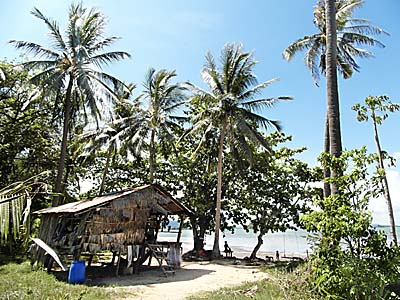
The shack of a fisherman's family on Rabbit Island / Koh Tonsay. Image by Asienreisender, 2014
However, it seems that the waters are already overfished as usually along the coastlines. It frequently happens that Vietnamese fisherboats are entering the surroundings to fish in Cambodian waters. That's due to the closeness to the Vietnamese border to the eastern side as well as the presence of the big Vietnamese island Phu Quoc west of Rabbit Island. Some other, smaller islands further south of Rabbit Island are also Vietnamese.
It's possible to have a walk around the small island (2km2 only), following a jungle track. Alltogether there are four beaches on the island. Most of the coastline is overgrown by a dense vegetation, much of it is mangrove forest. Only one of the beaches, the largest, which faces the western side, has a small touristic infrastructure. That consists of basic bamboo huts for sleeping and simple restaurants for hanging out and consumption. After sunset (around 6:30pm) there is some electricity produced by (noisy) generators. They are shut off after (or before) the last guests finished their consumption. It's said there would be mobile phone reception, but no internet, except it's based on a SIM-card and get's reception from the nearest mobile tower in Kep.
The sweetwater supplies are coming from a mountain spring. In the dry season it could happen that the island's water is running short, and additional water supplies have to be brought from Kep.

West beach with the touristic infrastructure. In the week are few guests here. The water is shallow and warm. At nighttime there is fluourescence in the water.
However, in the hot season it's hard to find sleep in the heat. Since the power generators are shut off early, there is no electricity for running a fan. One of the places, as I heared, runs the generator all night for the guests; probably only if there are enough guests.
Image by Asienreisender, 5/2014

Southeast beach on Rabbit Island. The hilly inland of Koh Tonsay is covered with tropical rain forest. Image by Asienreisender, 5/2014
Map of Rabbit Island

A map of Rabbit Island / Koh Tonsay.
History
In the 1940s and 1950s the island got populated by convicts. The remains of buildings of the time is sparsely, most of it is rotten by the time in the wet, tropical climate. The track is supposed to be built in that time. Presumably there were no permanent inhabitants on the island before that time.
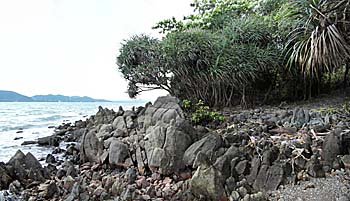
Most of Rabbit Island's coastlines are coined by mangrove forests. Image by Asienreisender, 2014
Name
The origin of the name is somewhat unclear. Official sources claim the word 'Tonsay' is derived from 'Rumsay'. In an unknown time a prince fled with his exhausted troops onto the island and let them spread out there in the jungle to hide them from their haunters. 'Rumsay' refers to that. 'Tonsay', the Khmer translation for 'rabbit', is a derivation of this former name.
Others claim that 'Tonsay' was the given name for the island for it's shape reminds to a rabbit. Personally I have never seen a rabbit in Southeast Asia and the one who might have called the island after a rabbit certainly didn't see a rabbit either (in his whole life), for there is absolutely no similarity. Others see the shape of a rabbit in the silhouette of the island's hills. Hmmm...
Since the tourists cause so much littering one could call the isle also rubbish island, for that is clearly to see with bare eyes. However, the local's have a hard time every morning to clean their places from the litter of last night.
